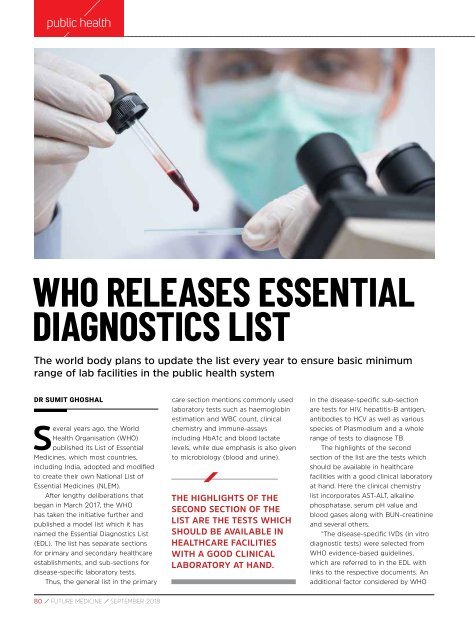FM SEPTEMBER 2018 ISSUE - digital edition
You also want an ePaper? Increase the reach of your titles
YUMPU automatically turns print PDFs into web optimized ePapers that Google loves.
public health<br />
WHO RELEASES ESSENTIAL<br />
DIAGNOSTICS LIST<br />
The world body plans to update the list every year to ensure basic minimum<br />
range of lab facilities in the public health system<br />
DR SUMIT GHOSHAL<br />
Several years ago, the World<br />
Health Organisation (WHO)<br />
published its List of Essential<br />
Medicines, which most countries,<br />
including India, adopted and modified<br />
to create their own National List of<br />
Essential Medicines (NLEM).<br />
After lengthy deliberations that<br />
began in March 2017, the WHO<br />
has taken the initiative further and<br />
published a model list which it has<br />
named the Essential Diagnostics List<br />
(EDL). The list has separate sections<br />
for primary and secondary healthcare<br />
establishments, and sub-sections for<br />
disease-specific laboratory tests.<br />
Thus, the general list in the primary<br />
care section mentions commonly used<br />
laboratory tests such as haemoglobin<br />
estimation and WBC count, clinical<br />
chemistry and immune-assays<br />
including HbA1c and blood lactate<br />
levels, while due emphasis is also given<br />
to microbiology (blood and urine).<br />
THE HIGHLIGHTS OF THE<br />
SECOND SECTION OF THE<br />
LIST ARE THE TESTS WHICH<br />
SHOULD BE AVAILABLE IN<br />
HEALTHCARE FACILITIES<br />
WITH A GOOD CLINICAL<br />
LABORATORY AT HAND.<br />
In the disease-specific sub-section<br />
are tests for HIV, hepatitis-B antigen,<br />
antibodies to HCV as well as various<br />
species of Plasmodium and a whole<br />
range of tests to diagnose TB.<br />
The highlights of the second<br />
section of the list are the tests which<br />
should be available in healthcare<br />
facilities with a good clinical laboratory<br />
at hand. Here the clinical chemistry<br />
list incorporates AST-ALT, alkaline<br />
phosphatase, serum pH value and<br />
blood gases along with BUN-creatinine<br />
and several others.<br />
“The disease-specific IVDs (in vitro<br />
diagnostic tests) were selected from<br />
WHO evidence-based guidelines,<br />
which are referred to in the EDL with<br />
links to the respective documents. An<br />
additional factor considered by WHO<br />
80 / FUTURE MEDICINE / <strong>SEPTEMBER</strong> <strong>2018</strong>


















